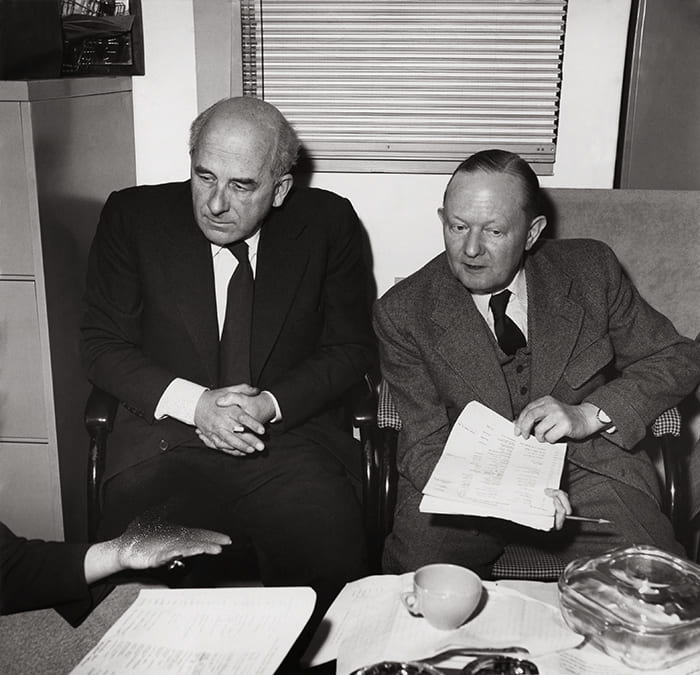
Brian O’Rorke
Architect (1907-1964)
Edward Brian O’Rorke was born in Christchurch, New Zealand on 14th June 1901. Educated at Wellington College, Jesus College, Cambridge and the Architectural Association School of Architecture he was awarded the RIBA Dawnay Prize in 1926. Five years later he was a runner-up in the competition to design the new headquarters building for the Royal Institute of British Architects (RIBA). In this same year, 1932, he also designed the Mayor Gallery, one of the first art galleries in Cork Street.
On the grounds that he had never designed a small country house before O’Rorke was chosen as the architect for Ashcombe Tower in Devon (1933-6), a house that was Arts & Crafts on the outside and Modern Movement in the interior. His modernist style brought him to the attention of Colin Anderson who commissioned the thirty-four year old O’Rorke to design the interior arrangement and decoration of his new passenger liner RMS Orion (1935). Such was the success of his revolutionary designs that, within the architectural profession, the Orion was always known as the ‘O’Rorke’. He was also involved with the interior design of several more Orient Line ships and received the RIBA bronze medal in 1947 for the Orient Building in Sydney. When Heal’s in Tottenham Court Road held an exhibition in 1936 of contemporary furniture designed by seven architects O’Rorke’s dining chairs were described by a reviewer for The Times as ‘possibly the most “elegant” pieces in the exhibition’.
His ability to produce clean, functional modern interiors in a restricted area led O’Rorke to receive the commission for the saloon of the LMS ‘Royal’ train in 1938. The following year the RSA appointed O’Rorke a Royal Designer for Industry (RDI) for his interior decoration, especially of ships. It’s not surprising therefore that he took the chair when Sir Colin Anderson gave a talk at the RSA on ‘The interior design of passenger ships’ (1966). O’Rorke also served as a judge for the furniture section of the RSA’s Industrial Art Bursaries competition (1946) and in 1957 he was one of the RDI judges for the first Design Centre awards for ‘Designs of the Year’ (1957). O’Rorke was one of the members of the RDI Faculty to pay an official visit to the Enterprise Scotland exhibition as well as various manufacturing plants in the area. In his 1962 talk to the RSA, to mark the 25th anniversary of the founding of the Faculty, O’Rorke said that over this twenty-five year period ‘good design had penetrated…to a considerable depth into the world of Industry and Commerce’. Designers were now being called on to work in new fields and the challenge for the future ‘would be to face up to the dangers and appreciate the possibilities for good for the mass-production machine age’. He also expressed concerns around design education. At the commemorative dinner, held on 21st November 1962, he was presented, as Master of the Faculty, with a ceremonial badge of office, a gift from the RSA designed by RDI and former Master, Robert Goodden.
O’Rorke was appointed the architect for The National Theatre in 1946, following the death of Edwin Lutyens. However, changes to the location led to O’Rorke’s scheme being abandoned. He designed alterations for the Royal Shakespeare Theatre in 1951 and, in this same year, designed two installations for the ‘Land of Britain’ Pavilion for the Festival of Britain’, as well as drawing up plans for the new Royal Observatory at Herstmonceux, Sussex. O’Rorke was the architect for the ‘Derby Hall’ student accommodation at Nottingham University (1963) and the Berkeley Hotel, Knightsbridge, which when it opened in 1972, boasted London’s only rooftop swimming pool.
He died two years later, at the age of 72, on 1st March 1974. Author and illustrator, Nicolas Bentley, who did the illustrations for the ‘Things in Their Home Setting’ section of the Britain Can Make It exhibition catalogue, gave the address at O’Rorke’s memorial service held at St James’s Piccadilly the following month.
Britain Can Make It Exhibition Catalogue 1946
- Manager’s Office – page 116
To view and search the catalogue online, please visit our digital document library.
To learn more about the work of Brian O’Rorke, his relationships with other designers, and further resources, visit the Exploring British Design prototype web portal.
Original image reference: GB-1837-DES-DCA-30-1-POR-G-44-1. Brian O’Rorke on the left, photographed with Milner Gray. Design Council Archive, University of Brighton Design Archives.

